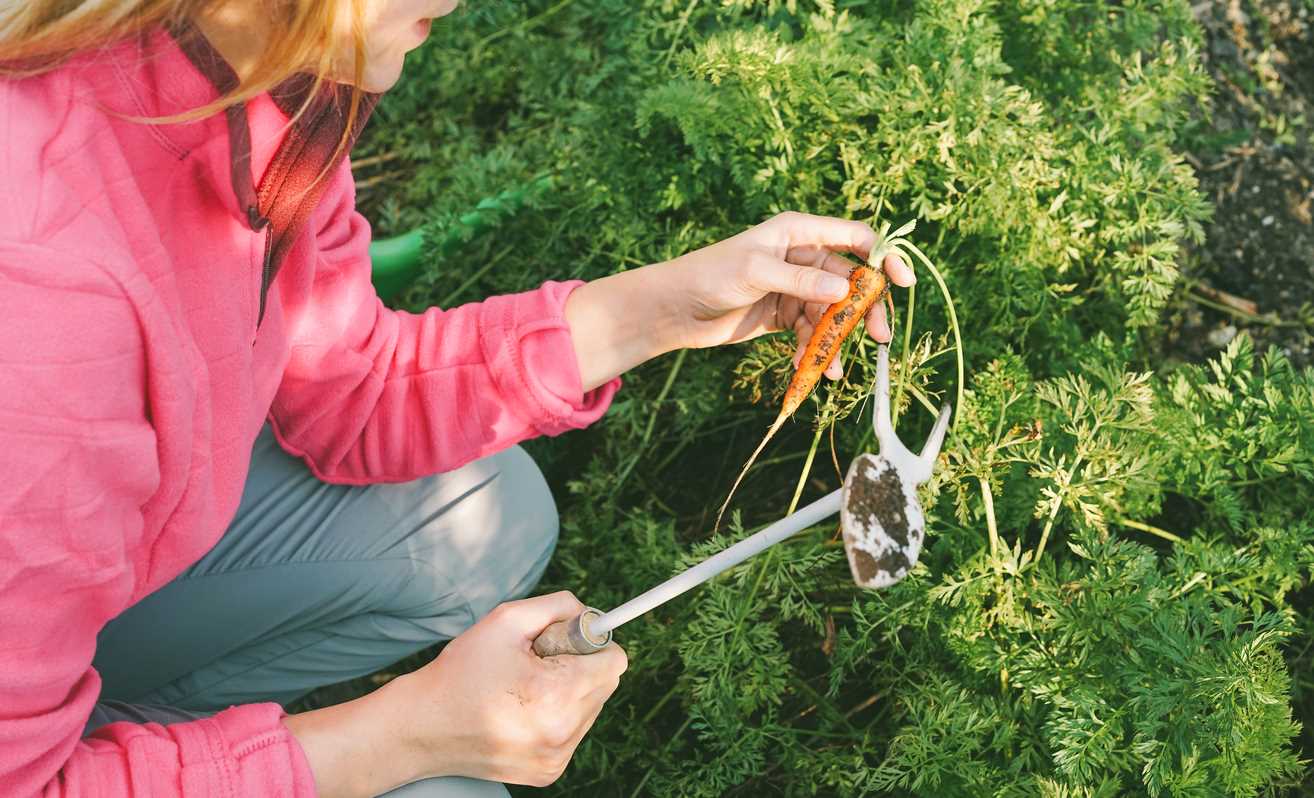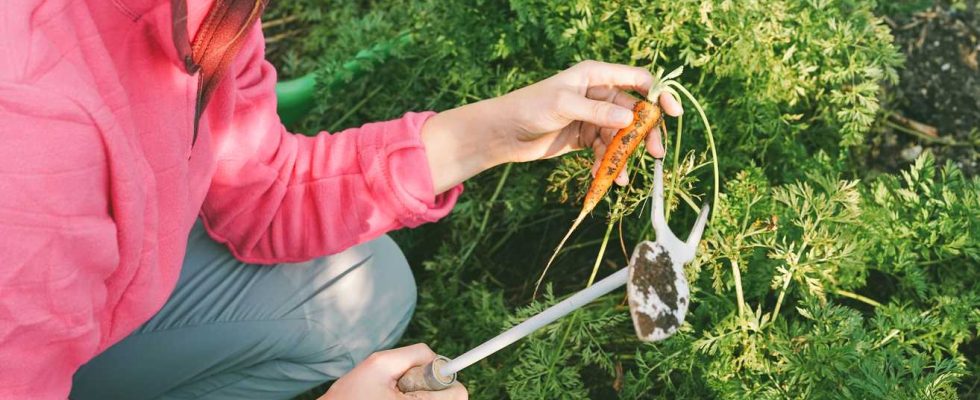
Learn more about carrots
Some facts about carrots
From the Apiaceae family, the carrot, whose Latin name is Daucus carota, is a root vegetable of which we consume the taproot cooked or raw. Even though we don’t really get to see it, this biennial plant flowers. In fact, if you do not dig up the root the first year, it produces white flowers in umbels, then seeds.
The carrot is an interesting dish to eat, because it is rich in carotene, then transformed into vitamin A by the liver, vitamins B1, B2 and C, fiber and sugars. Furthermore, being made up of 90% water, it is ideal for use in juice. Although the orange carrot is the most common, there are white, purple, red, yellow, etc., depending on the variety.
Carrot varieties
Carrots are, in fact, available in many varieties which are differentiated by their size, their color, their flavor, but above all, their harvest period.
Depending on which ones you choose, they will need to be grown at different times and the growing method may even be different. To find your way around, the different varieties are grouped into categories, according to their harvest period:
- Early carrots: they are harvested in April or May. Among them, the red-fleshed ‘De Carentan’ carrot, the ‘Marché de Paris’ carrot, the ‘Nantaise 2’ carrot, etc.
- Seasonal carrots: they are harvested during the summer. Among them, the ‘Nantaise Improved’ carrot, the ‘Rothild’ carrot, the ‘Atomic red’ carrot, etc.
- Storage carrots : they are harvested from fall to winter. Among them, the ‘Colmar à coeur rouge’ carrot, the ‘Gniff’ carrot, the Saint-Valery carrot, etc.
Growing conditions
Carrots can be grown under cover or in the ground:
- Under shelter : you can opt for cultivation simply under a frame or in a tunnel, but also in a cold greenhouse. The advantage of this method of cultivation is that you will benefit from early carrots and that you will be able to produce early carrots which can be harvested 2 months after sowing.
- In open ground without protection: you must then sow your carrots in rich and fresh soil, rather sandy. If the soil in your vegetable garden is poor, dry or stony, it will be important to prepare it beforehand, as we will see a little later. As for exposure, choose a sunny location. This type of sowing will be carried out for summer carrots, but also late carrots.
Consider growing your carrots on a plot where there hasn’t been a root vegetable for 3 or 4 years.
Whether you grow your carrots under cover or in the ground, germination can only take place once temperature between 10 and 30°C.
When to sow carrots?
As we have seen, depending on the carrot varieties, the harvest period is different and, logically, the same goes for the sowing period.
- Early carrots: they must be sown under cover between January and March. This is then what is called an early culture.
- Seasonal carrots: they can be sown in the ground from March or April, depending on the climate in your region.
- Storage carrots: they can be sown from May to July. This is then what is called a late culture.
Sowing carrots correctly
Prepare the ground
As we saw previously, carrots need cool, deep, sandy soil to grow well. This involves carefully preparing the land before sowing:
- If the soil in your vegetable garden is rather dry or insufficiently drained, you can add sand to the soil.
- If the soil in your vegetable garden is poorenrich it, some time before sowing, with compost.
- UA week before sowing your carrots, false-seeding. This means preparing the growing area as if you were going to sow. To do this, you must decompact the earth deeply and carefully crumble the surface. Then water the area, then wait at least a week. The advantage of this preliminary work is that it allows weeds to emerge and you can eliminate them before sowing your carrots.
Carry out the seedlings
Before sowing carrot seeds
Even if it is not obligatory, it is recommended to refrigerate them. Likewise, you can soak carrot seeds in a glass of water for a whole day. Without being essential, these actions promote and accelerate germination.
To sow carrot seeds
Carrots do not support transplanting, seeds should be sown directly in place, whether in the ground or under cover. To do this :
- Prepare rows 15 cm apart for short carrots, 20 cm for semi-long carrots or 25 cm for long carrots.
- You then just have to distribute the seeds on each of these rows, taking care to be light on the quantity of seeds, because they are very small. To achieve a better distribution of seeds and a more correct dosage, it is possible to mix carrot seeds with sand or coffee grounds. This will allow you to sow in more limited quantities and will prevent you from having to then carry out too tedious thinning.
- After sowing the seeds, pack the area with the back of your rake or with a roller. The seeds will thus be in good contact with the soil.
- To finish, carry out rain watering. It is possible to use a veil to keep the ground moist and make starting easier.
- It is necessary to count between 10 and 20 days for the seeds to emerge.
Thin out seedlings
To allow the carrots to develop properly, it is necessary to thin out the seedlings twice during the growing period:
- The first time : you must thin out the first time as soon as the plants have between 4 and 5 leaves, which corresponds to approximately 3 cm in height.
- The second time : you must repeat this operation between 10 and 15 days later when the carrots are more developed. This will allow you to keep enough space for each of them. On a row, the ideal is to preserve a space of 6 cm between short carrots, 7 cm between semi-long carrots and 10 cm between long carrots.
Caring for seedlings
Caring for a carrot seedling comes down to two operations:
- Watering: carrots only require occasional and moderate watering. You can mulch the soil to help it stay cool and limit watering. To know when to water, observe the growth of the tops. When they go to bed, it is necessary to water.
- Hoeing and weeding: you must ensure that your carrot rows are kept clean, hoeed and weeded, especially at the start. Indeed, if your carrots grow among weeds, they will have to seek light, which will result in greater development of the tops to the detriment of the roots. It is therefore important to force yourself to weed regularly from the start, because if you wait too long, you will not be able to make up for this false start and your carrots will remain stunted.
Companion plants
It is possible to grow your carrots near crops of onions, leeks, shallots or garlic, plants which help fight against the presence of the carrot fly. Likewise, you can install your carrots near your tomatoes, lettuce or radishes which will create a favorable environment. Conversely, keep them away from potatoes, beets or dill.
Harvesting and conservation
Harvest
If the root of the carrot is more generally consumed, the tops can also be consumed. As we have seen, the harvest takes place more or less long after sowing depending on the carrots:
- Early carrots are to be harvested approximately 3 months after sowing.
- Seasonal carrots are to be harvested 4 to 5 months after sowing.
- As for storage carrotsthey should be harvested 6 months after sowing.
This means that if you have diversified the varieties and staggered the sowing, you can harvest carrots for a large part of the year. To harvest your carrots, simply pull on the tops to dig up the root. You can also use a garden fork.
The carrot loses a large part of its taste qualities when it is subjected to cold. This is why it is recommended to harvest them before frost and to protect crops when temperatures are low.
Conservation
If you want to preserve your carrots, proceed as follows:
- After digging, let your carrots dry on the ground for 3 to 4 hours.
- Then cut the tops above the collar.
- Place the roots in a box filled with sand, making sure they do not touch each other.
- Place the crate in a cellar. You can keep them for between 3 and 4 months.
You can also bury them in the vegetable garden or blanch them before freezing.
Pests and diseases
Carrots have a fairly low tolerance to pests and diseases.
- They can thus be reached alternaria, or black rot. This disease is linked to excess humidity.
- Its main parasite is the carrot fly.. Generally, the largest infestations occur between July and August. To protect your carrots from this fly, you can use an anti-insect veil or consider combining your carrot crop with leek and garlic crops.

